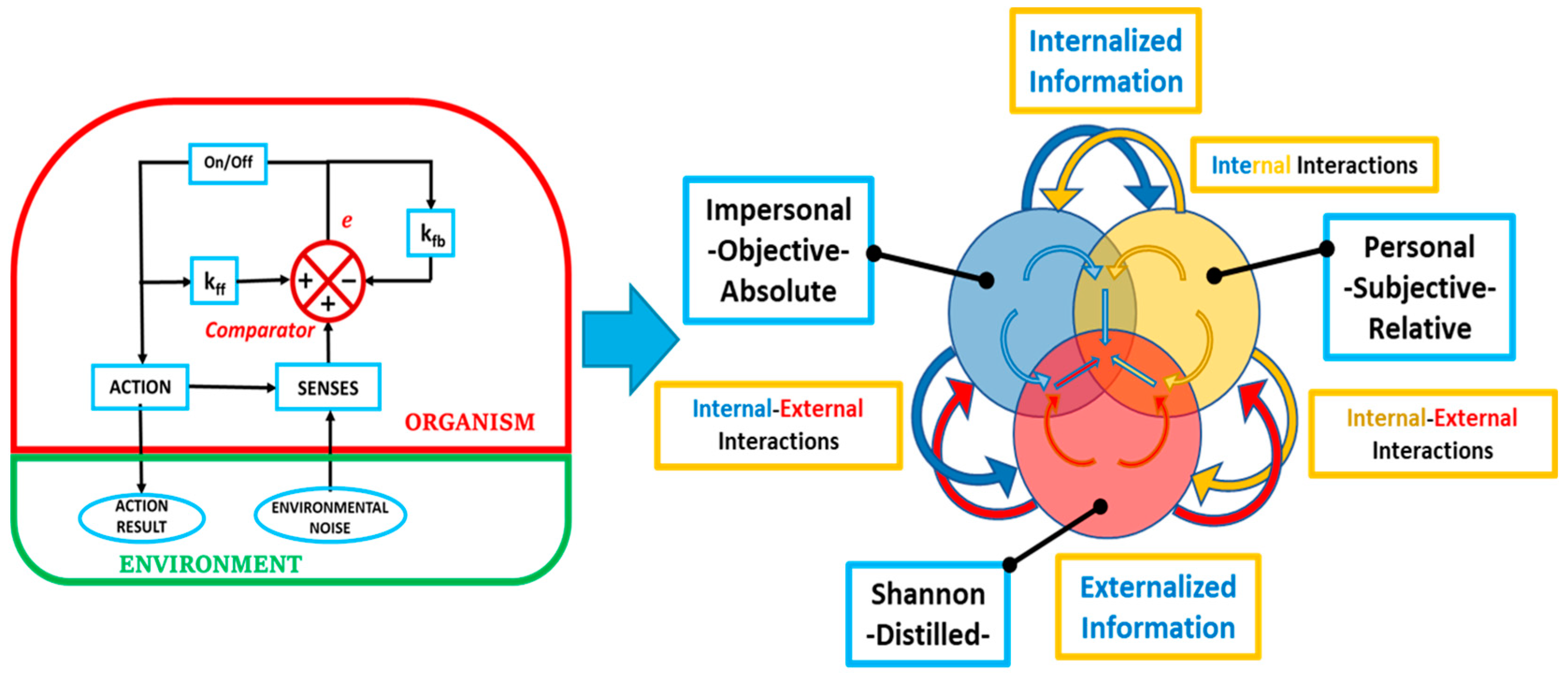Info-Autopoiesis and Digitalisation †
Abstract
1. Introduction
2. A Communication System
3. Info-Autopoiesis
4. Info-Autopoiesis and Digitalisation
5. Summary and Conclusions
Funding
Institutional Review Board Statement
Informed Consent Statement
Data Availability Statement
Acknowledgments
Conflicts of Interest
References
- Bateson, G. Steps to an Ecology of Mind: Collected Essays in Anthropology, Psychiatry, Evolution, and Epistemology; Chandler Publications for Health Sciences; Ballantine Books: New York, NY, USA, 1978; 545p. [Google Scholar]
- Pattee, H.H. Epistemic, Evolutionary, and Physical Conditions for Biological Information. Biosemiotics 2013, 6, 9–31. [Google Scholar] [CrossRef]
- Capurro, R.; Hjørland, B. The concept of information. Ann. Rev. Inform. Sci. Technol. 2003, 37, 343–411. [Google Scholar] [CrossRef]
- Hofkirchner, W. Emergent Information. When a Difference Makes a Difference…. tripleC 2013, 11, 6–12. [Google Scholar] [CrossRef][Green Version]
- Hofkirchner, W. How to achieve a unified theory of information. In What Is Information? Proceedings of the First International Meeting of Experts in Information, Leon, Spain, 6–8 November 2008; Universidad de León: Leon, Spain, 2008. [Google Scholar]
- Capurro, R. Past, present, and future of the concept of information. tripleC 2009, 7, 125–141. [Google Scholar] [CrossRef]
- Díaz Nafría, J.M. What is information? A multidimensional concern. tripleC 2010, 8, 77–108. [Google Scholar] [CrossRef]
- Peters, J.D. Information: Notes Toward a Critical History. J. Commun. Inquiry 1988, 12, 9–23. [Google Scholar] [CrossRef]
- Deacon, T.W. Emergence: The Hole at the Wheel’s Hub. In The Re-Emergence of Emergence: The Emergentist Hypothesis from Science to Religion; Clayton, P., Davies, P., Eds.; Oxford University Press: Oxford, UK, 2008; pp. 111–150. [Google Scholar]
- Shannon, C.E. A Mathematical Theory of Communication. Bell Syst. Tech. J. 1948, 27, 379–423. [Google Scholar] [CrossRef]
- Shannon, C.E.; Weaver, W. The Mathematical Theory of Communication; The University of Illinois Press: Urbana, IL, USA, 1949. [Google Scholar]
- MacKay, D.M. Information, Mechanism and Meaning; MIT Press: Cambridge, MA, USA, 1969. [Google Scholar]
- Dretske, F.I. Knowledge and The Flow of Information; MIT Press: Cambridge, MA, USA, 1981. [Google Scholar]
- Stonier, T. Information and Meaning—An Evolutionary Perspective; Springer: Berlin/Heidelberg, Germany; New York, NY, USA, 1997. [Google Scholar]
- Floridi, L. The Philosophy of Information; Oxford University Press: Oxford, UK, 2011; 405p. [Google Scholar]
- Cárdenas-García, J.F.; Ireland, T. The Fundamental Problem of the Science of Information. Biosemiotics 2019, 12, 213–244. [Google Scholar] [CrossRef]
- Cárdenas-García, J.F. The Process of Info-Autopoiesis—The Source of all Information. Biosemiotics 2020, 13, 199–221. [Google Scholar] [CrossRef]
- Cárdenas-García, J.F. Distributed Cognition: An Ectoderm-Centric Perspective. Biosemiotics 2013, 6, 337–350. [Google Scholar] [CrossRef]
- Cárdenas-García, J.F.; Ireland, T. Human Distributed Cognition from an Organism-in-its-Environment Perspective. Biosemiotics 2017, 10, 265–278. [Google Scholar] [CrossRef]
- Burgin, M.; Cárdenas-García, J.F. A Dialogue Concerning the Essence and Role of Information in the World System. Information 2020, 11, 406. [Google Scholar] [CrossRef]
- Kurzweil, R. How to Create a Mind: The Secret of Human thought Revealed; Viking: New York, NY, USA, 2012; 336p. [Google Scholar]


Publisher’s Note: MDPI stays neutral with regard to jurisdictional claims in published maps and institutional affiliations. |
© 2022 by the author. Licensee MDPI, Basel, Switzerland. This article is an open access article distributed under the terms and conditions of the Creative Commons Attribution (CC BY) license (https://creativecommons.org/licenses/by/4.0/).
Share and Cite
Cárdenas-García, J.F. Info-Autopoiesis and Digitalisation. Proceedings 2022, 81, 82. https://doi.org/10.3390/proceedings2022081082
Cárdenas-García JF. Info-Autopoiesis and Digitalisation. Proceedings. 2022; 81(1):82. https://doi.org/10.3390/proceedings2022081082
Chicago/Turabian StyleCárdenas-García, Jaime F. 2022. "Info-Autopoiesis and Digitalisation" Proceedings 81, no. 1: 82. https://doi.org/10.3390/proceedings2022081082
APA StyleCárdenas-García, J. F. (2022). Info-Autopoiesis and Digitalisation. Proceedings, 81(1), 82. https://doi.org/10.3390/proceedings2022081082





